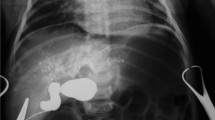Abstract
Purpose
To investigate and compare ultrasound (US) findings for the diagnosis of biliary atresia (BA) in infants younger than 30 days with those of infants older than 30 days.
Materials and Methods
From 2000 to 2015, we reviewed hepatobiliary US images in 12 BA infants younger than 30 days (younger BA group) and 62 BA infants older than 30 days (older BA group) before Kasai procedure. Eight (67%) of younger BA group underwent follow-up US examinations before Kasai procedure. Our review of the images focused on triangular cord sign, gallbladder (GB) abnormalities, vascular changes, and signs of portal hypertension.
Results
The triangular cord sign was present in 17% of younger BA group and in 56% of older BA group (P=.024). GB abnormalities were commonly identified in both groups. The hepatic artery diameter was significantly smaller in younger BA group than in older BA group (P<.001). Signs of portal hypertension were less common in younger BA group (17%) than in older BA group (84%) (P<.001). Follow-up US of two infants in younger BA group showed a new appearance of the triangular cord sign.
Conclusion
BA infants younger than 30 days showed atypical US findings compared with those older than 30 days.
Key Points
• BA infants younger than 30 days show atypical US findings.
• GB abnormalities were common in both younger and older BA group.
• Subsequent US examination may be helpful to diagnose BA in young infants.



Similar content being viewed by others
References
Sokol RJ, Shepherd RW, Superina R, Bezerra JA, Robuck P, Hoofnagle JH (2007) Screening and outcomes in biliary atresia: summary of a National Institutes of Health workshop. Hepatology 46:566–581
Serinet MO, Wildhaber BE, Broue P et al (2009) Impact of age at Kasai operation on its results in late childhood and adolescence: a rational basis for biliary atresia screening. Pediatrics 123:1280–1286
Hartley JL, Davenport M, Kelly DA (2009) Biliary atresia. Lancet 374:1704–1713
El-Guindi MA, Sira MM, Sira AM et al (2014) Design and validation of a diagnostic score for biliary atresia. J Hepatol 61:116–123
Saxena AK, Mittal V, Sodhi KS (2012) Triangular cord sign in biliary atresia: does it have prognostic and medicolegal significance? Radiology 263:621 author reply 621-622
Lee SY, Kim GC, Choe BH et al (2011) Efficacy of US-guided percutaneous cholecystocholangiography for the early exclusion and type determination of biliary atresia. Radiology 261:916–922
Azar G, Beneck D, Lane B, Markowitz J, Daum F, Kahn E (2002) Atypical morphologic presentation of biliary atresia and value of serial liver biopsies. J Pediatr Gastroenterol Nutr 34:212–215
Lee HJ, Lee SM, Park WH, Choi SO (2003) Objective criteria of triangular cord sign in biliary atresia on US scans. Radiology 229:395–400
Mittal V, Saxena AK, Sodhi KS et al (2011) Role of abdominal sonography in the preoperative diagnosis of extrahepatic biliary atresia in infants younger than 90 days. AJR Am J Roentgenol 196:W438–W445
Tan Kendrick AP, Phua KB, Ooi BC, Tan CE (2003) Biliary atresia: making the diagnosis by the gallbladder ghost triad. Pediatr Radiol 33:311–315
Kim WS, Cheon JE, Youn BJ et al (2007) Hepatic arterial diameter measured with US: adjunct for US diagnosis of biliary atresia. Radiology 245:549–555
Megremis SD, Vlachonikolis IG, Tsilimigaki AM (2004) Spleen length in childhood with US: normal values based on age, sex, and somatometric parameters. Radiology 231:129–134
Humphrey TM, Stringer MD (2007) Biliary atresia: US diagnosis. Radiology 244:845–851
Zhou LY, Wang W, Shan QY et al (2015) Optimizing the US Diagnosis of Biliary Atresia with a Modified Triangular Cord Thickness and Gallbladder Classification. Radiology 277:181–191
Zhou L, Shan Q, Tian W, Wang Z, Liang J, Xie X (2016) Ultrasound for the Diagnosis of Biliary Atresia: A Meta-Analysis. AJR Am J Roentgenol 206:W73–W82
Lee SM, Cheon JE, Choi YH et al (2015) Ultrasonographic Diagnosis of Biliary Atresia Based on a Decision-Making Tree Model. Korean J Radiol 16:1364–1372
Choi SO, Park WH, Lee HJ, Woo SK (1996) ‘Triangular cord’: a sonographic finding applicable in the diagnosis of biliary atresia. J Pediatr Surg 31:363–366
Kotb MA, Kotb A, Sheba MF et al (2001) Evaluation of the triangular cord sign in the diagnosis of biliary atresia. Pediatrics 108:416–420
Kanegawa K, Akasaka Y, Kitamura E et al (2003) Sonographic diagnosis of biliary atresia in pediatric patients using the “triangular cord” sign versus gallbladder length and contraction. AJR Am J Roentgenol 181:1387–1390
Farrant P, Meire HB, Mieli-Vergani G (2000) Ultrasound features of the gall bladder in infants presenting with conjugated hyperbilirubinaemia. Br J Radiol 73:1154–1158
Lee MS, Kim MJ, Lee MJ et al (2009) Biliary atresia: color doppler US findings in neonates and infants. Radiology 252:282–289
El-Guindi MA, Sira MM, Konsowa HA, El-Abd OL, Salem TA (2013) Value of hepatic subcapsular flow by color Doppler ultrasonography in the diagnosis of biliary atresia. J Gastroenterol Hepatol 28:867–872
Ramesh RL, Murthy GV, Jadhav V, Ravindra S (2015) Hepatic subcapsular flow: An early marker in diagnosing biliary atresia. Indian J Radiol Imaging 25:196–197
Funding
The authors state that this work has not received any funding.
Author information
Authors and Affiliations
Corresponding author
Ethics declarations
Guarantor
The scientific guarantor of this publication is Tae Yeon Jeon.
Conflict of interest
The authors of this manuscript declare no relationships with any companies, whose products or services may be related to the subject matter of the article.
Statistics and biometry
One of the authors has significant statistical expertise.
Informed consent
Written informed consent was waived by the Institutional Review Board.
Ethical approval
Institutional Review Board approval was obtained.
Methodology
• retrospective
• case-control study
• performed at one institution
Rights and permissions
About this article
Cite this article
Hwang, S.M., Jeon, T.Y., Yoo, SY. et al. Early US findings of biliary atresia in infants younger than 30 days. Eur Radiol 28, 1771–1777 (2018). https://doi.org/10.1007/s00330-017-5092-5
Received:
Revised:
Accepted:
Published:
Issue Date:
DOI: https://doi.org/10.1007/s00330-017-5092-5




